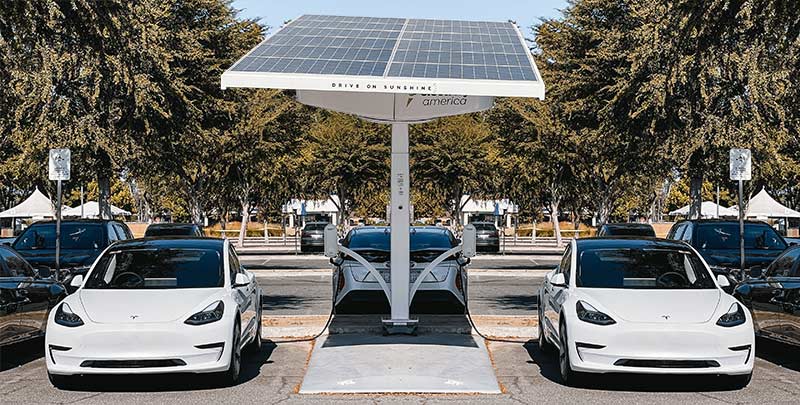Table of Contents
Electric vehicles (EVs) are rapidly transforming the landscape of fleet operations, as businesses across industries recognize the environmental benefits and cost savings realized by electrifying their fleets.
However, for those who are new to running EV fleets, navigating the maintenance landscape can feel unfamiliar. After all, unlike traditional gas-powered types of vehicles, EVs require a different approach to maintenance.
Unlike traditional gasoline-powered vehicles that require regular oil changes, filter replacements, and exhaust system checks, EVs have far fewer moving parts. This translates to a reduced need for services like engine oil changes, lubrication of various components, and inspections of hoses and belts.
Additionally, with no fuel to burn, concerns about fuel efficiency, fuel costs, and the environmental impact of emissions are virtually eliminated.
However, this doesn’t mean EVs are entirely maintenance-free. Regular checks on tire pressure, battery health, and software updates are still crucial for optimal performance and longevity.
If you’re a business owner transitioning to EV fleets for the first time, this article will serve as a roadmap to help you develop a comprehensive and effective maintenance plan.
What Is a Maintenance Plan?
A well-defined vehicle maintenance plan is the cornerstone of a successful and effective fleet operation, regardless of vehicle type. It’s a proactive strategy that prioritizes preventing problems before they occur, ensuring the safety and efficiency of your fleet.
There are two approaches to maintenance management: preventive and reactive. Preventive maintenance tasks include routine vehicle inspections, scheduled servicing, and replacing worn parts before they reach the end of their lifespan. Reactive maintenance, on the other hand, addresses issues only after they arise, often leading to breakdowns, costly repairs, and operational disruptions.
Why Preventative Maintenance?
Transitioning to an EV fleet presents a unique opportunity to embrace a preventative and regular maintenance approach. Unlike their gas-powered counterparts, EVs have fewer moving parts, significantly reducing the potential for mechanical breakdowns. However, this doesn’t eliminate the need for a robust maintenance program that incorporates regular maintenance intervals.
Here’s why a well-structured preventative maintenance plan is crucial for EV fleets:
Safety: Addressing minor issues vie regular service intervals, before they escalate into major problems, minimizes the risk of accidents and on-road breakdowns.
Operational cost reductions: Regular servicing helps identify and address minor problems early on, preventing them from developing into important repair costs.
Uptime and operational predictability: Planned maintenance minimizes unplanned downtime, keeping your fleet operational – and ensuring that operating conditions are predictable.
Customer satisfaction: Reliable and efficient fleet vehicles contribute to a positive customer experience, especially for businesses dealing with deliveries or ride-sharing services.
Regulatory compliance: Certain maintenance procedures may be mandated by regulations to ensure vehicle safety and environmental responsibility.
Reduced environmental impact: Maintaining EVs properly ensures optimal performance, maximizing their range and minimizing energy consumption.
Fleet Management Plan Essentials
Developing a comprehensive maintenance checklist for your EV fleet requires a systematic approach to data collection, reporting, and performance measurement.
Here are some key elements to consider:
Tracking the right data
Vehicle identification number (VIN)
Odometer readings
Battery health data (state of health [SOH], remaining useful life [RUL])
Charging history and infrastructure details
Maintenance history (service records, parts replaced)
Accident reports
Data capture methods
Implement a fleet management software system specifically designed for EVs. Such fleet maintenance software solutions can automate record keeping, streamline reporting, and send maintenance reminders.
Utilize diagnostic tools provided by EV manufacturers to monitor battery health and detect potential electrical system issues.
Integrate telematics systems to track vehicle location, driving behavior, and energy consumption in real time.
Metrics for success
Maintenance costs per vehicle
Vehicle downtime due to repairs
Average battery degradation rate
Fleet uptime and operational efficiency
Customer satisfaction metrics (on-time deliveries, service quality)
Getting Started: Launching Your Maintenance Program
Now that we’ve established the importance of preventative maintenance and the data required to track progress, let’s delve into the steps involved in implementing a robust maintenance program for your EV fleet:
Framework and reporting: Design a structured process for scheduling maintenance activities, including periodic inspections, battery health checks, and software updates. Ensure a clear reporting system to capture service details, parts used, and technician notes. This data will be invaluable for identifying trends, optimizing maintenance schedules, and justifying future investments.
Facilities: Evaluate your existing facilities to ensure they accommodate EV charging and maintenance needs. Consider investing in charging infrastructure and acquiring specialized tools and equipment required for EV repairs.
Expertise: Identify qualified technicians with experience and training in servicing EVs. Partnering with authorized EV service centers can ensure your maintenance team has the necessary expertise to address any problems effectively.
Parts management: Establish a streamlined system for parts ordering and inventory management. Due to the relative infancy of EV technology, parts availability might be a factor. Partner with reliable vendors and maintain a buffer stock of critical components to minimize downtime.
Documentation: Maintain comprehensive documentation for each vehicle in your fleet. This includes service records, repair details, warranty information, and battery health reports. A centralized document repository will prove invaluable for tracking maintenance history, identifying recurring issues, and optimizing future maintenance schedules.
By following these guidelines and building a robust fleet maintenance program, you can ensure your electric vehicles operate efficiently and reliably, propelling your business toward a sustainable and successful future.
Conclusion
Building a successful EV fleet goes beyond simply acquiring electric vehicles. Implementing a well-defined preventative maintenance program is key to maximizing uptime, minimizing costs, and ensuring the safety and efficiency of your operations.
By embracing a data-driven approach, prioritizing preventative maintenance schedules, and partnering with qualified service providers, you can ensure your new vehicles deliver on their promise of environmental responsibility and economic advantage.
As the EV landscape continues to evolve, a proactive and adaptable maintenance strategy will position your business for long-term success in the ever-evolving world of electric transportation.
How Spring Free EV Can Help
Spring Free EV specializes in providing innovative financial solutions for electric vehicle fleets and can significantly help fleet managers mitigate risks. Our services are designed to address the key challenges fleet managers face when adopting electric vehicles:
- First, our low down payments offer financial flexibility and lower upfront costs.
- We also understand the concerns around battery life and replacement costs, and will work with you to mitigate the risks associated with battery degradation.
- In addition, we advise and support fleet managers as they install charging stations on-site on company premises and along key routes. This is part of our commitment to provide fleet managers with access to resources, tools, and fleet management software that help optimize operational efficiency.
- The bottom line: We make it easy to scale with popular electric vehicles, with leasing structures built for high mileage taxi, car rental, and corporate/company vehicle use.
Contact us today to see how we can help you manage risk as you acquire an EV fleet.

